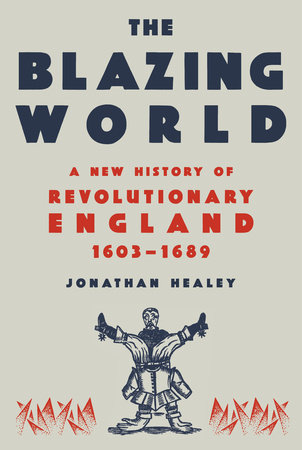The Blazing World: A New History of Revolutionary England, 1603-1689
- By Jonathan Healey
- Knopf
- 512 pp.
- Reviewed by Allison Thurman
- April 12, 2023
A sweeping account of an especially volatile British era.

It’s a cliché to say that history repeats itself, especially since it often doesn’t. Oxford professor Jonathan Healey makes it clear in The Blazing World that the figures discussed within — Oliver Cromwell, William Laud, and the Stuart monarchs from James I to Charles II, among a cast of many more — could only have existed during their unique time. And yet, “The echoes of seventeenth-century England are still with us,” he writes, “in our society, in the built environment and in the very landscape.”
The similarities between those times and our own (on both sides of the Atlantic) are impossible to ignore. At the beginning of the 1600s, harvests were good, so England experienced a period of increased prosperity. Due to improving schools, literacy swelled and publications proliferated, creating a better-informed middle class. For perhaps the first time, those beneath the gentry engaged with new ideas and had the confidence to take their debates out of the taverns and into Parliament.
Literacy and debate also visited cultural institutions that had seldom been questioned before. This created a first-of-its-kind “culture war” in which independent preachers and congregations challenged the hegemony of the Church of England. Rather than being mandated by the monarchy as in eras past, religious reformation was coming from the masses.
Eventually, the rising population led to land scarcity, lower wages, and a correspondingly higher cost of living. Combined with monopolies on major industries like soap, these burdens, by the 1630s, created an educated but unemployed class unable to get ahead. “For young men who had expected to become fathers and husbands — householding patriarchs — the failure to do so generated frustration, resentment, and anger,” writes Healey. With the levying of taxes to pay for a war to enforce religious conformities already under debate, the stage was set for conflict.
Charles I was king, and his belief in his divine right to rule came into direct conflict with a variety of constituencies within Parliament that insisted a king must prove himself a “lawful magistrate” of his realm. Some groups were more radical than others, but all agreed ultimate sovereignty lay with the people. Any ruler who hoped to reign needed to accept this new political consciousness. Charles I refused and paid for it with his head.
The Blazing World recounts the English Civil War, of course, but I found its historical context about events leading up to the conflict far more interesting than its chronicling of battles and military leaders. The interactions among religious dissenters and the rumblings over the proper roles of Parliament and the Crown were so subtle and complex that even the slightest change — what if Charles I had accepted political reforms? What if the leader of the Parliamentary moderates hadn’t died before the king’s principal advisor was tried for treason? — might’ve stopped the country’s slide to war.
The postwar Protectorate and subsequent Restoration form the second half of the book and were no less complicated or nuanced than the periods preceding them. The war brought to power people who’d grown up amid England’s rising population and social stress; they were eager to exercise that power. While Charles II’s ascendance to the throne led to religious oppression and crackdowns on the press, Parliamentary and popular dissent — like the republic itself — nevertheless lived on.
The Blazing World covers an entire century and spotlights countless people, places, and events. At times, it was difficult to keep track of all the different actors, especially as political factions and religious sects adapted and re-created themselves during volatile periods. Even so, the march of progress — in the form of more elaborate economies and a decline in violent crime and equally violent punishment — runs through the book like a thread of hope.
“The political world we live in today, with regular Parliaments and elections, ideologically defined parties, a vibrant press and mass campaigns [centered] on large protests and petitions, was born in the seventeenth century,” asserts Healey. “For this, as well as so much else, the story told here remains fascinating and vital to this day.”
What’s heartening is the story’s suggestion that the long arc of history tends to bend, however slowly, toward improvement.
Allison Thurman has a longstanding interest in 16th-century history and is currently editing her first novel, about the Elizabethan medium Edward Kelley. She lives in Gaithersburg, MD, with too many books and not enough swords.

